Hex Shogi
by Fergus Duniho
Hex Shogi is a class of Shogi variants played on a hexagonal board. The variants of Hex Shogi are distinguished by their boards. The first Hex Shogi variant was Hex Shogi 41, which I created for the Contest to design a Chess variant with 41 spaces. As it happened, 41 was a suitable number for a small hexagonal board, and I came up with the idea for Hex Shogi while contemplating what use I could make of this board. After coming up with the concept, I applied it to some more suitable boards. One is the 91-space hexagonal board that is itself shaped like a hexagon and is used by such popular Chess variants as Glinski's Hexagonal Chess and McCooey's Hexagonal Chess. Another board is the straightforward transformation of the usual Shogi board into a hexagonal board. This transformation simply changes the square spaces into hexagons, resulting in a rhombus shaped board. Using these two boards resulted in Hex Shogi 91 and Hex Shogi 81. These three games are all played by the same rules and differ only in what boards are used and how the pieces are set up. For the sake of economy, the rules are described in detail here and in only abbreviated form on the pages for the individual variants.
There is also a three player version of Hex Shogi, called Three Player Hex Shogi 91, but its rules are a bit different than the rules given here for two player variants.
Board Characteristics
A hexagon has two main orientations. It can lie on one of its sides, or it can stand on a corner. In Hex Shogi, every board is made up of hexagons that stand on a corner. This is important, because the orientation of a hexagon determines which directions are forward, which are backward, which are orthogonal, and which are diagonal. It also affects whether there will be horizontal ranks or vertical files. On a hexagonal board, there is only one or the other, not both. In Hex Shogi, there are horizontal ranks but no vertical files. Instead of vertical files, there are left-leaning files and right-leaning files. On a hexagonal board, there are twelve different directions. Six are orthogonal, and six are diagonal. Two hexagons are orthogonally adjacent if they share a common side, and they are diagonally adjacent if they are connected only at a corner. On a hexagonal board, diagonally adjacent hexagons do not actually touch each other. They are connected by a side belonging to one or two hexagons that are orthogonally adjacent to each of them. Since there are twelve different directions, the directions on a hexagonal board may be represented by the hours on a clock face. The orthogonal directions match the odd hours on a clock face, and the diagonal directions match the even hours. In terms of degrees, the orthogonal directions are 30, 90, 150, 210, 270, and 330 degrees, and the diagonal directions are 0, 60, 120, 180, 240, and 300 degrees. There are two orthogonally forward directions, 30 and 330 degrees (1 and 11 o'clock). And there are three diagonally forward directions, 300, 0, and 60 degrees (10, 12, and 2 o'clock). The five backward directions are 180 degrees (or 6 hours) away from these. The orientation of the hexagons affects how most of the pieces move. Lances, Knight, and Pawns can only move forward, and the Gold and Silver Generals move differently forward and backward. Thus, the orientation of the hexagons affects what moves are available for these pieces. If hexagons that lie on their sides were used instead, these pieces would all move differently than they do in Hex Shogi. How each piece moves is covered in the individual piece descriptions.
Rules
Object
You win by checkmating your opponent's King. You also win if your opponent resigns. Stalemate is a draw. Stalemate can occur if a player has no legal move available, the exact same position has been repeated three times, or fifty turns have passed without anyone capturing a piece. These are all standard stalemating conditions for other Chess variants, but I expect these conditions are rare in any kind of Shogi game. A game is also a draw if both players agree to it.
Captures
When a piece is captured, it comes into the possession of the player who captures it. That player may hold it in hand and use a subsequent turn to drop it on the board. When a promoted piece is captured, it reverts back to its unpromoted state.
Dropping
A piece held in hand may be dropped on the board as a player's turn. With some restrictions, a piece may be dropped on any empty space.
A piece may not be dropped where it would have no legal move on an empty board. This restriction affects Pawns, Lances, and Knights. It keeps Pawns and Lances from being dropped on the back rank, and it keeps Knights from being dropped on the last two ranks. On a very unusually shaped board, it could entail other restrictions.
A Pawn may not be dropped on a space defended by another of your unpromoted Pawns. This restriction replaces the Shogi rule against dropping a Pawn in the same file as another one of your unpromoted Pawns.
A Pawn may not be dropped where it would check the opponent's King. This restriction replaces the weaker rule in Shogi against using a Pawn drop to checkmate an opponent's King. It is further compensation for dispensing with the one-pawn-to-a-file rule of Shogi, which just won't work on a board without vertical files.
Promotion
When a piece that can promote enters, leaves, or moves within the opponent's territory, it may promote. Each player's territory extends from his first rank to the furthest rank occupied by any of his pieces when the game starts. The size of this territory is usually about one third of the board. In Hex Shogi 41 and Hex Shogi 81, it is the first three ranks of each player. In Hex Shogi 91, it is the first four ranks. When a piece moves where it would otherwise have no more legal moves in any possible scenario, it must promote. So Pawns and Lances must promote upon reaching the last rank, and Knights must promote upon reaching either of the last two ranks. Which pieces can promote, and what any promote to, is covered in the individual piece descriptions. A piece cannot promote by being dropped into the opponent's territory. For it to promote, it must move after it is dropped, and this can be done only on a subsequent turn.
Pieces
The pieces described here are the ones presently used in the first few Hex Shogi variants. These are merely the same pieces used in Modern Shogi, except that they have all been adapted for a board made of hexagons that stand on a corner. Future Hex Shogi variants may use pieces not mentioned here. All movement diagrams were made from the center space in Hex Shogi 91, but these pieces move the same in all Hex Shogi variants.
 King
King

The King moves one space in any orthogonal or diagonal direction. This is the same as how the King moves in other Hexagonal Chess variants. It may not move to any space where it could be captured. A King does not promote.
 Gold General
Gold General
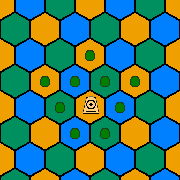
The Gold General of Shogi is the Japanese version of the Wazir, which can move one space orthogonally. The Gold General adds to the power of the Wazir the ability to move forward in any direction. Hence, the Gold General of Hex Shogi can move one space in any orthogonal direction or one space in any diagonally forward direction. With a maximum of six orthogonally adjacent hexagons and three more diagonally adjacent hexagons in front of it, a Gold General has up to nine spaces it can move to. A Gold General does not promote.
 Silver General
Silver General
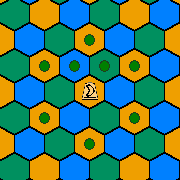
The Silver General of Shogi is the Japanese version of the Ferz, which can move one space diagonally. The Silver General adds to the power of the Ferz the ability to move forward in any direction. Hence, the Silver General of Hex Shogi can move one space in any diagonal direction or one space in any orthogonally forward direction. With a maximum of six diagonally adjacent hexagons and two more orthogonally adjacent hexagons in front of it, a Silver General has up to eight spaces it can move to. A promoted Silver General moves exactly the same as a Gold General, which is described above.
 Lance
Lance
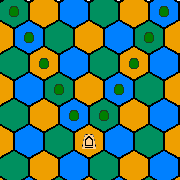
The Lance slides in a straight line orthogonally forward. On a Hex Shogi board, this gives a Lance two directions it can move in. The Lance cannot move backwards. When it moves in the opponent's territory, it may promote to a piece that moves just like a Gold General. Upon reaching the last rank, a Lance must promote.
 Knight
Knight
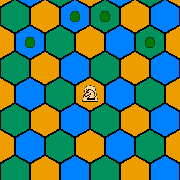
Like the Shogi Knight, the Hex Shogi Knight can only move forward. It moves one space orthogonally forward, then one space diagonally outward. Another way to describe its movement is to say that it moves two spaces in the same orthogonally forward direction then turns 60 degrees left or right and moves one more space. Because there are two different orthogonally forward directions, a Knight can cover up to four different spaces. When it moves in the opponent's territory, it may promote to a piece that moves just like a Gold General. Upon reaching one of the last two ranks, a Knight must promote.
 Pawn
Pawn
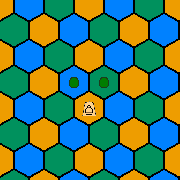
A Pawn moves and captures one space orthogonally forward. On a Hex Shogi board, this gives it two different spaces it can move to, which allows Pawns to occupy a common file. Because of this, the rule from Shogi against dropping a Pawn on a file already occupied by a friendly Pawn is left out. Instead of this, a Pawn may not be dropped on a space defended by another Pawn. As further compensation for the loss of the one-pawn-to-a-file rule, a Pawn drop may not check the opponent's King. When a Pawn moves in the opponent's territory, it may promote to a Tokin, which moves as a Gold General. Upon reaching the last rank, a Pawn must promote.
 Rook
Rook

The Rook slides in a straight line across orthogonally adjacent hexagons. It may not jump pieces. On a Hex Shogi board, it may move left, right, left forward, right forward, left backward, and right backward. When moving in the opponent's territory, a Rook may promote to a Dragon King, which is described below.
 Dragon King
Dragon King
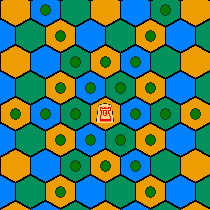
The Dragon King is a promoted Rook. It can move one space diagonally or move as a Rook.
 Bishop
Bishop
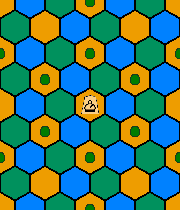
The Bishop slides in a straight line across diagonally adjacent squares. It may not jump pieces. On a Hex Shogi board, it may move up or down in addition to the four directions a Bishop can move in Chess or Shogi. Despite being able to move in directions normally belonging to Rooks, the movement of a Bishop remains colorbound. When a Bishop moves in the opponent's territory, it may promote to a Dragon Horse, which is described below.
 Dragon Horse
Dragon Horse
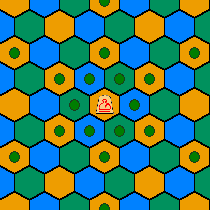
A Dragon Horse is a promoted Bishop. It can move one space orthogonally or move as a Bishop.
Zillions of Games
Three Hex Shogi variants--Hex Shogi 41, 81, and 91--have been implemented for Zillions of Games. You may download them here:
Note: These ZRFs require at least Zillions 1.1.1. They use the translate and multiple piece set features of 1.1.1. File last updated on 22 November 2000.